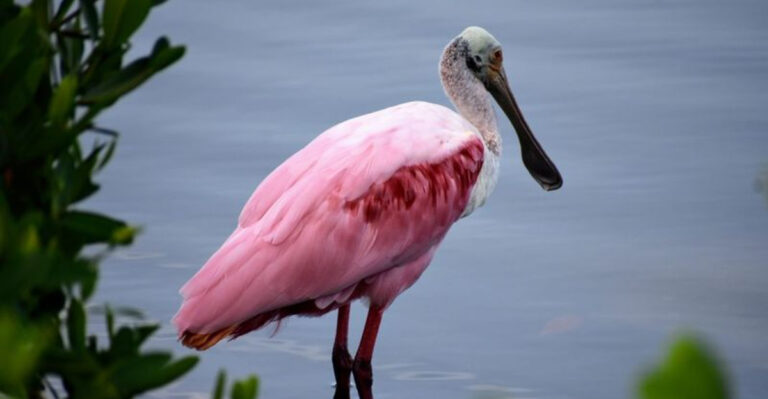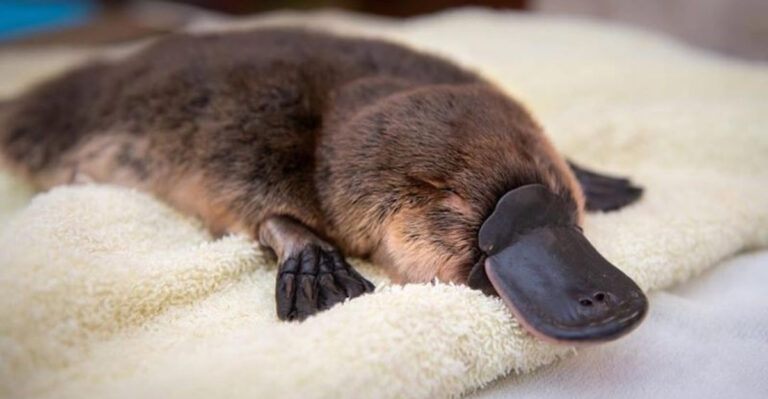17 Exotic Fish Species That Inhabit Florida’s Coral Reefs
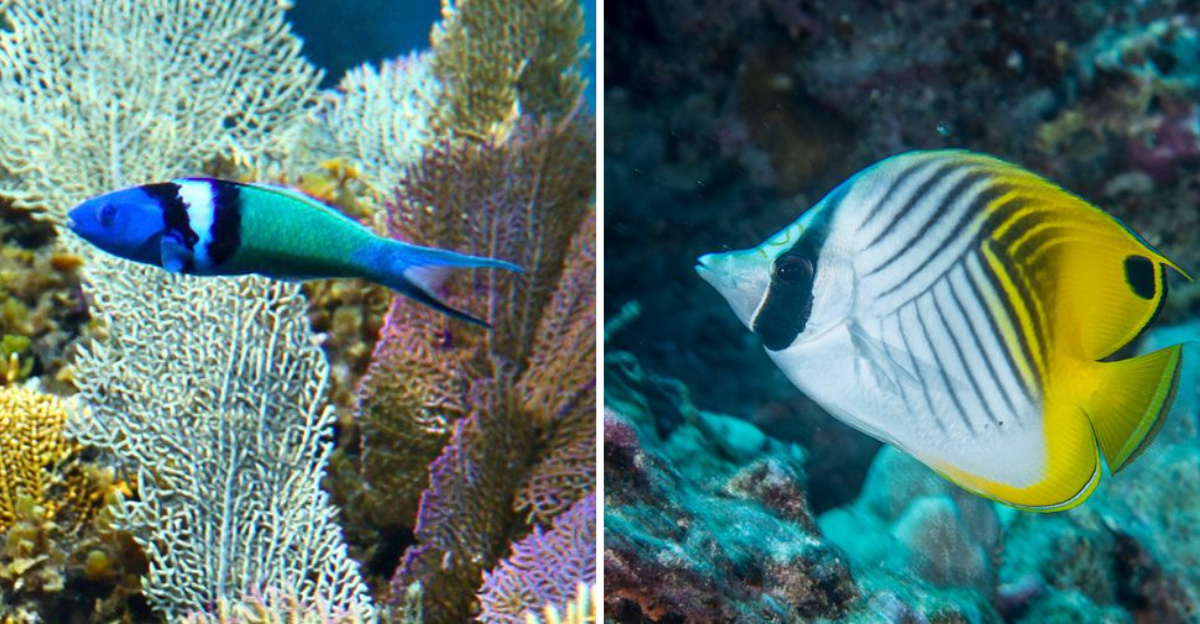
Florida’s coral reefs are underwater wonderlands filled with some of the most colorful and unusual fish on our planet.
These living rainbows dart between coral formations, creating a magical display for snorkelers and divers.
The warm waters around the Florida Keys and southeastern coast provide the perfect home for these fascinating creatures, many of which can’t be found anywhere else in the United States.
1. Queen Angelfish
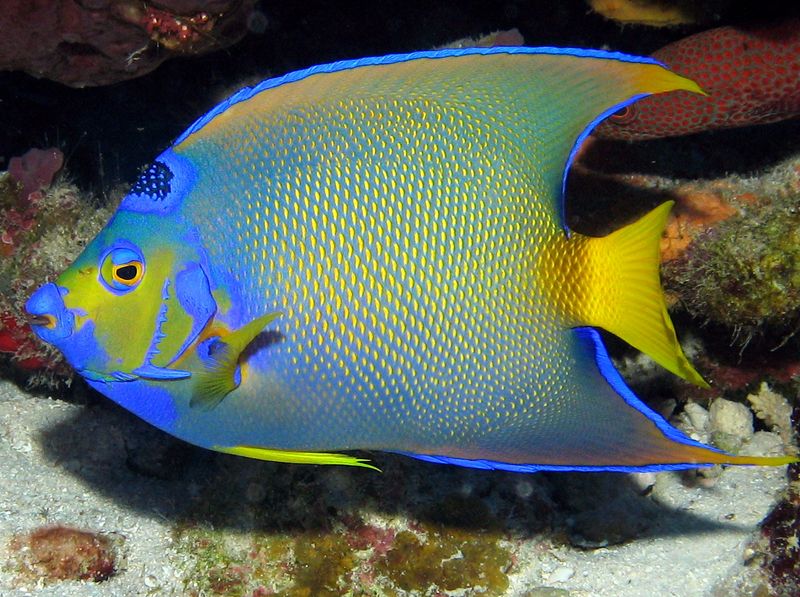
Dressed in electric blue with golden highlights, these swimming jewels look like they’re wearing crowns! The distinctive blue-ringed spot on their foreheads is called a “crown,” giving them their regal name.
Young queen angelfish start life with completely different colors than adults. They transform gradually as they grow, changing from dark blue with circular yellow rings to their adult royal pattern.
These fish are surprisingly picky eaters, dining primarily on sponges that most other fish avoid. They use their small mouths to pick tiny bits from the reef, helping keep coral healthy by preventing sponges from overgrowing.
2. Stoplight Parrotfish
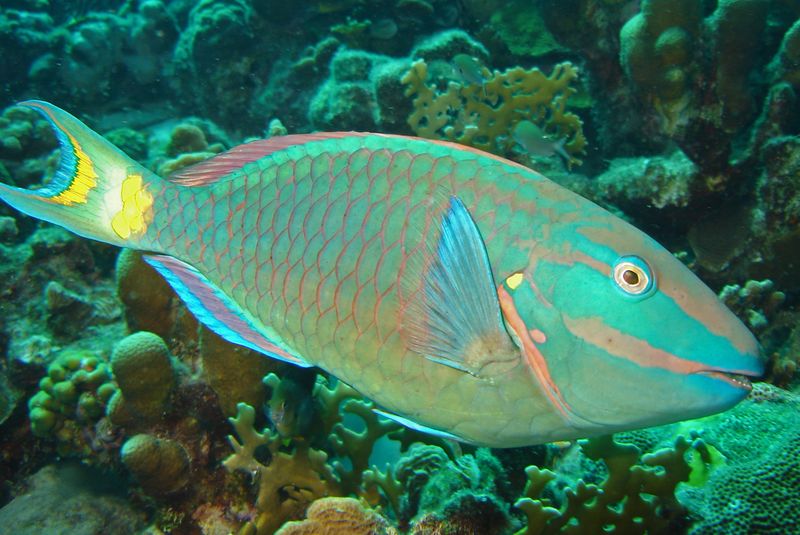
Imagine a fish that changes colors like a traffic light throughout its life! Young stoplights start greenish-brown, transition to a bright red-and-green phase, and finally become a stunning blue-green with rose-colored accents.
These reef architects literally make sand with their teeth. They chomp on coral, digest the tiny animals inside, and excrete the limestone as fine white sand – producing up to 700 pounds yearly per fish!
At night, stoplight parrotfish perform a bizarre bedtime ritual. They secrete a mucous cocoon around their bodies while sleeping, which masks their scent from predators and acts like an underwater sleeping bag.
3. Reef Butterflyfish
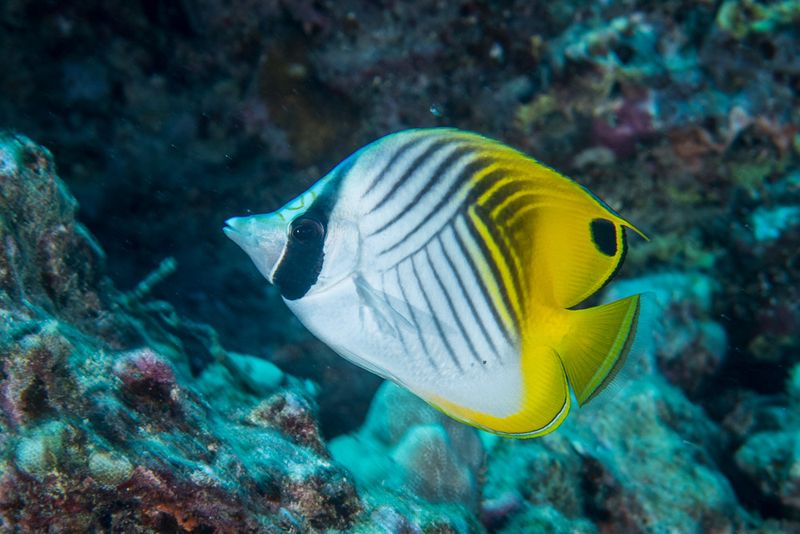
With their distinctive black masks across their eyes, these fish look like tiny bandits robbing the reef of its treasures! Their thin, disk-shaped bodies allow them to slip between tight coral spaces where predators can’t follow.
Reef butterflyfish form lifelong partnerships that would make any romance novelist swoon. They choose a mate and stay together their entire lives, swimming side by side during the day and sleeping together at night.
Their specialized pointy snouts work like tweezers, picking tiny organisms from coral crevices. Though only about 6 inches long, their striking yellow bodies with bold black stripes make them easy to spot against the blue Florida waters.
4. Blue Chromis
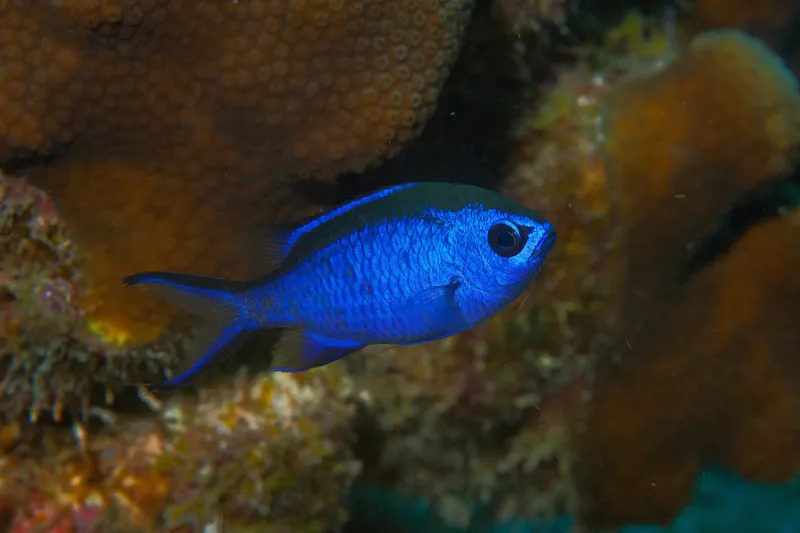
Flashing like electric-blue sparks in the water, these small fish create living clouds of color! When sunlight hits a school of blue chromis, the entire group seems to pulse with neon blue energy against the backdrop of Florida’s reefs.
Safety in numbers is their survival strategy. Blue chromis form tight schools that move in perfect unison, creating the illusion of being one large organism to confuse predators. Their vibrant color actually helps them blend together more effectively.
Morning and evening feeding times turn into underwater ballet performances. The entire school rises up from the reef together, feeds in the water column, then descends in synchronized movements that mesmerize divers lucky enough to witness them.
5. Spotfin Butterflyfish
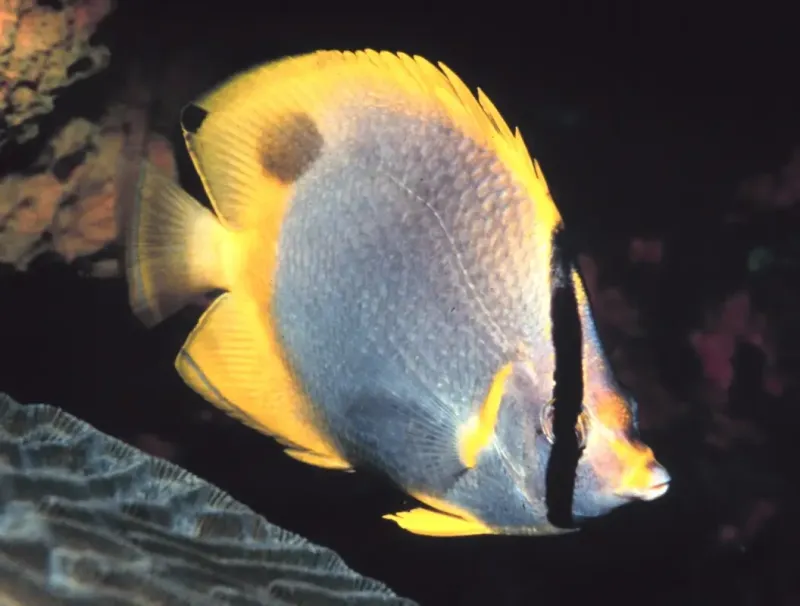
Sporting a distinctive black spot like a beauty mark on their yellow fins, these fish are the fashionistas of the reef! Their diamond-shaped bodies shimmer with yellow scales accented by vertical black stripes that seem painted on by an underwater artist.
These social butterflies of the sea travel in pairs, engaging in synchronized swimming that strengthens their bond. Watch closely and you’ll see them mirror each other’s movements perfectly, like dancers who’ve practiced for years.
Spotfins communicate through unique body positioning. They can signal danger, food sources, or territorial warnings by changing their swimming angle or flashing their distinctive fins – a sophisticated sign language invisible to the untrained human eye.
6. Sergeant Major
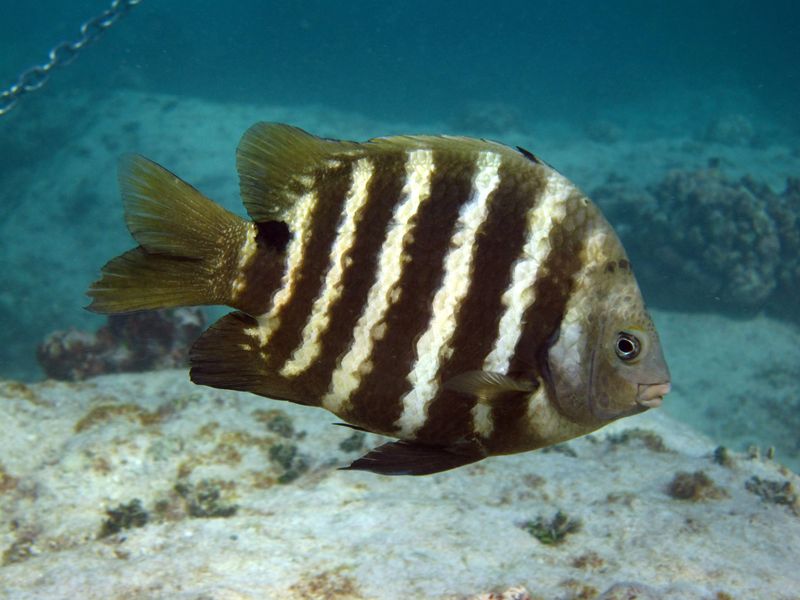
Five bold black stripes against a silvery-yellow background make these fish look like they’re wearing military uniforms! Their distinctive markings earned them their name, resembling the arm stripes on a military sergeant’s uniform.
Male sergeant majors become super-dads during breeding season. They turn partly blue, claim territory on the reef, and meticulously care for thousands of eggs. They’ll fiercely defend their purple egg patches against any threat, even challenging divers who swim too close!
These adaptable fish are among the friendliest in Florida waters. They often approach snorkelers with curious, fearless attitudes and have learned that humans sometimes bring food, making them popular ambassadors of the reef to visiting tourists.
7. Porkfish
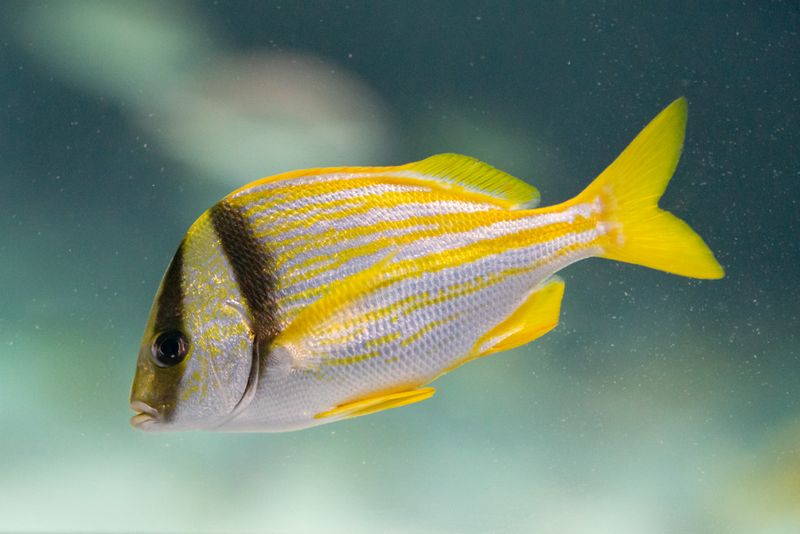
Two bold yellow stripes cutting across a silver body make these fish look like they’re wearing bright suspenders! The porkfish’s distinctive look includes a black spot near its tail and contrasting dark bars running through its eyes, creating a face that’s impossible to forget.
These social creatures transform from day to night. During daylight, they gather in large, peaceful schools browsing the reef. After sunset, they become active hunters, using special drumming muscles to make thumping sounds that help coordinate their nighttime feeding.
Young porkfish start life as reef cleaners. Juveniles set up “cleaning stations” where larger fish visit to have parasites removed – a perfect example of underwater cooperation that benefits both the cleaner and the cleaned.
8. Midnight Parrotfish
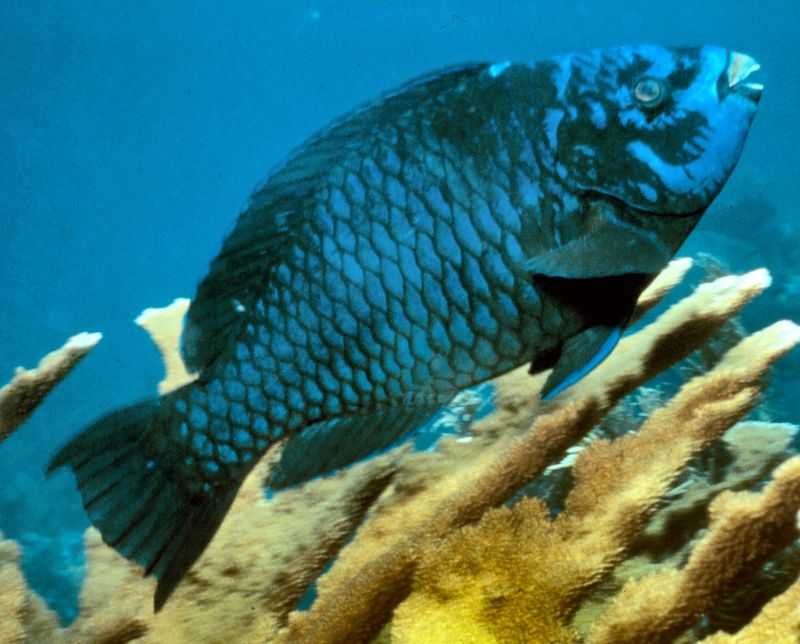
Under cover of darkness, these fish pull off one of the ocean’s most dramatic makeovers! During the day, midnight parrotfish display a handsome pattern of blue-green scales with reddish fins. But at night, they undergo a remarkable transformation, changing to a mottled cream-and-brown pattern that helps them hide while sleeping.
Their beaks could give woodpeckers competition. Fused teeth form powerful plates that can crunch through coral and rock to reach tasty algae. The grinding sound of parrotfish feeding can actually be heard by divers underwater!
These fish are essential reef janitors. By scraping algae off coral, they prevent overgrowth that would smother the living coral animals, making them critical to reef health in Florida’s delicate marine ecosystems.
9. French Angelfish
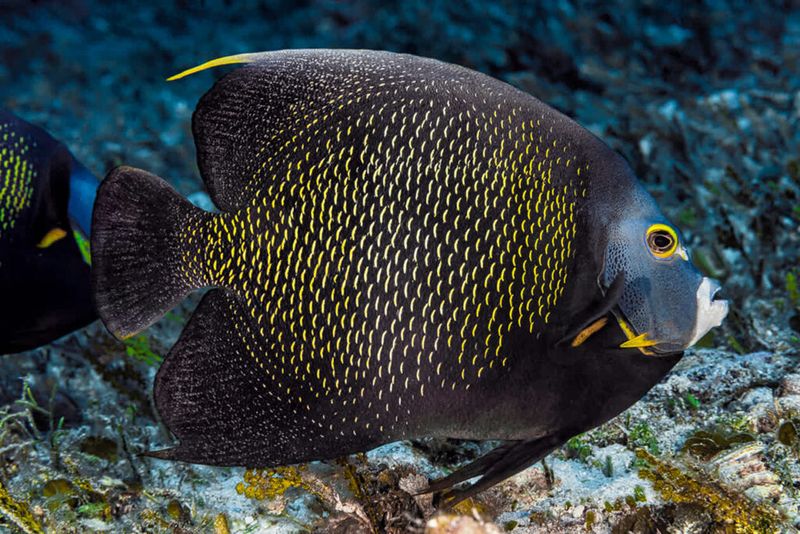
Yellow-rimmed scales create a stunning contrast against their inky-black bodies, making these fish look like they’re wearing fancy evening attire! Young French angelfish start life with dramatically different coloration – black with bright yellow vertical bars – before growing into their sophisticated adult appearance.
Romance isn’t dead on the reef. These fish form devoted pairs that stay together for life, hunting, defending territory, and navigating the reef side by side. They even coordinate their movements, swimming in perfect synchronization like underwater dancers.
French angelfish have entrepreneurial spirits. They run “cleaning stations” where they remove parasites from larger fish, including predators that would normally eat them – a remarkable example of underwater business relationships where everyone benefits!
10. Bluehead Wrasse
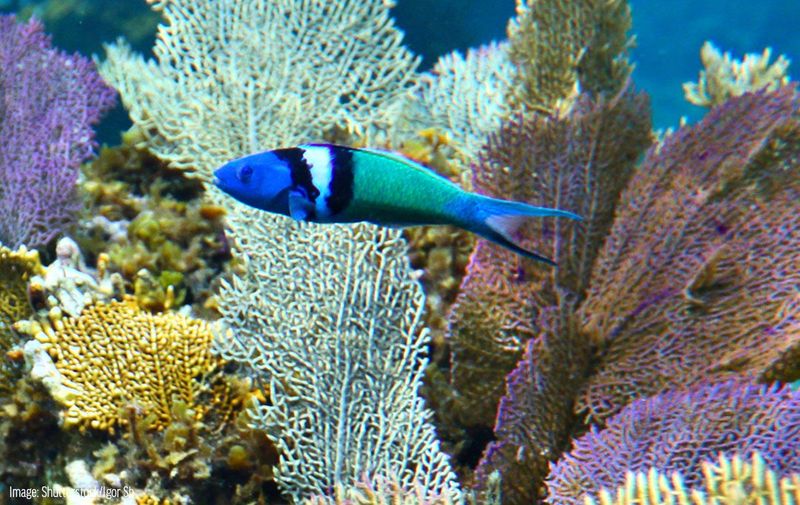
Masters of reinvention, these fish can completely change their gender, color, and social status! Males sport electric blue heads with green bodies, while females and juveniles wear modest yellow-and-black patterns – but here’s the twist: females can transform into males when needed.
Their social structure would make a fascinating reality show. Large terminal males with bright blue heads maintain harems of females. If the male disappears, the largest female undergoes a remarkable transformation, changing color and developing male reproductive organs in just a week!
These fish are the reef’s cleanup crew. They pick parasites off larger fish and eat damaging invertebrates that could harm coral. Their constant activity and bright colors make them one of the easiest fish for snorkelers to spot in Florida’s waters.
11. Longsnout Butterflyfish
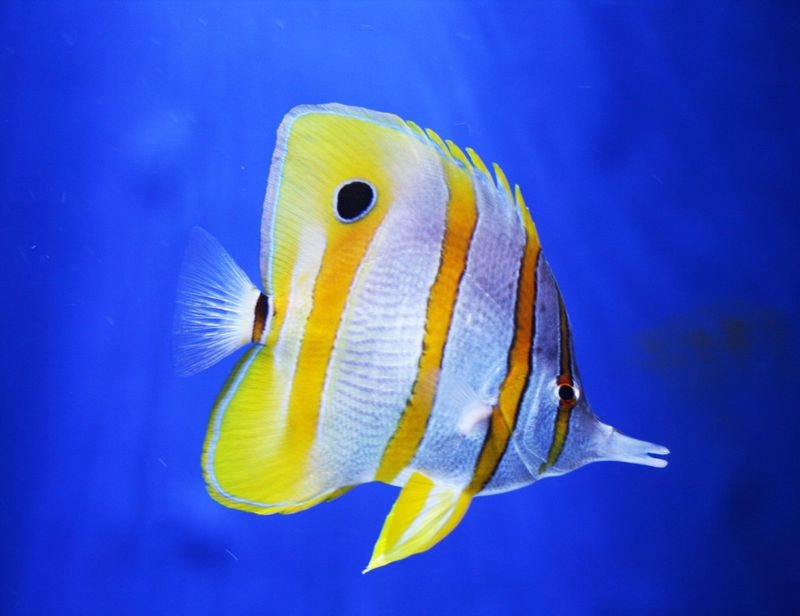
Armed with a snout that looks like a drinking straw, these specialized fish can reach places other reef dwellers can’t! Their elongated mouths work like precision tools, extracting tiny worms and other morsels from the narrowest coral crevices.
Fashion-forward in their appearance, longsnout butterflyfish wear a distinctive pattern of chocolate brown and white stripes, accented with a splash of yellow on their tails. A bold black dot near their tails works like a false eye, confusing predators about which end is which.
These fish maintain strong family values. They form dedicated pairs that defend their territory together against intruders. Partners stay close throughout the day, rarely separating by more than a few feet as they methodically search the reef for hidden treats.
12. Redband Parrotfish
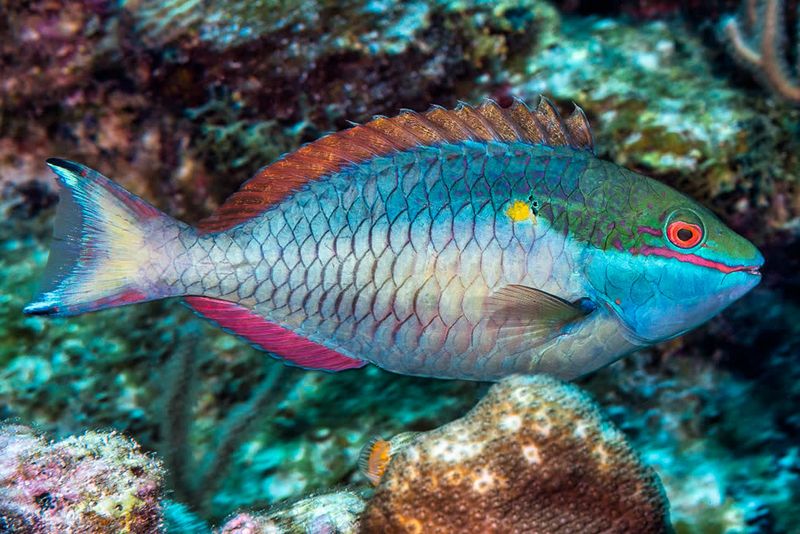
Sporting a vivid red band across their greenish bodies, these underwater landscapers literally reshape Florida’s reefs! Their powerful beaks can bite through solid coral with the pressure of 1,000 pounds per square inch – stronger than many industrial tools.
These fish are environmental engineers. When they chomp on coral to eat algae, they excrete fine sand that forms the beautiful white beaches Florida is famous for. A single redband parrotfish can produce hundreds of pounds of sand annually!
At night, they perform a bizarre bedtime ritual. They secrete a transparent mucous bubble around themselves before sleeping, which masks their scent from predators like sharks and moray eels – essentially creating their own protective sleeping bag on the reef floor.
13. Scrawled Filefish
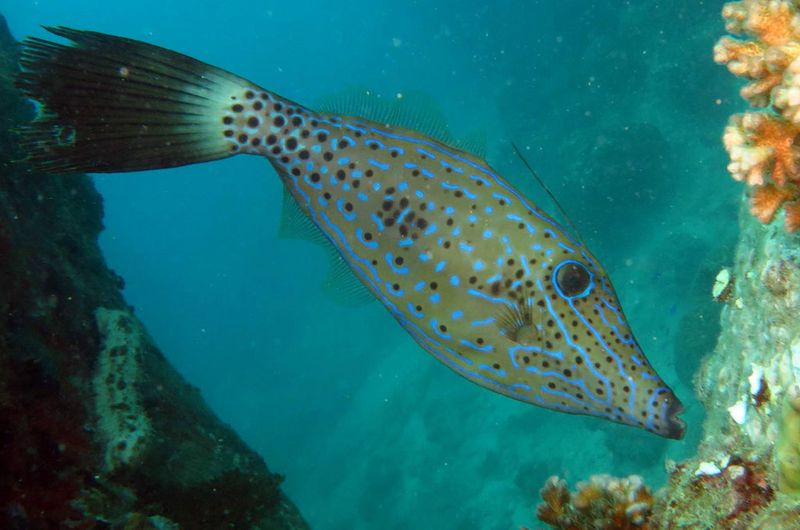
Looking like swimming pieces of abstract art, these oddball fish have bodies covered in seemingly random blue scrawls and lines! Their bizarre appearance isn’t random – it helps them blend with complex coral backgrounds, making them nearly invisible to both prey and predators.
Armed with a secret weapon, filefish can change colors to match their surroundings. They can shift from bright orange to muted browns and greens in minutes, adjusting their camouflage as they move across different parts of the reef.
Their strangest feature might be the modified dorsal spine on their heads. This spine can be raised or lowered like a switchblade, locking into place when threatened. Their rough, sandpaper-like skin (which gives them their name) provides additional protection from would-be predators in Florida’s waters.
14. Rock Beauty Angelfish
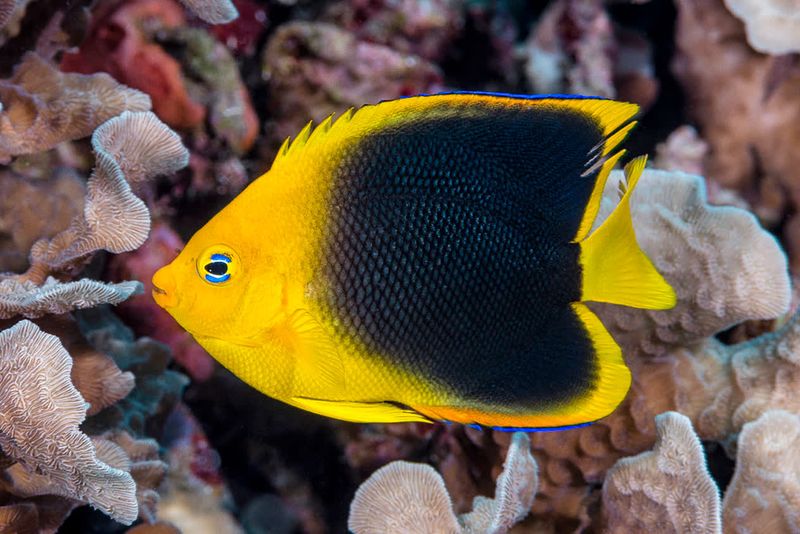
Half midnight-black, half golden-yellow – these fish look like they were painted by an artist who couldn’t decide on a color scheme! Their dramatic two-tone appearance makes them one of the most recognizable fish on Florida’s reefs.
Young rock beauties wear completely different outfits. Juveniles display brilliant yellow bodies with large blue eye spots on their backs – a disguise that makes predators think they’re facing a much larger fish. As they mature, their colors gradually shift to the distinctive half-and-half pattern.
These fish are pickier eaters than toddlers at dinnertime. They specialize in consuming certain sponges that most other reef fish avoid due to toxic compounds. Their specialized digestive systems can process these toxins, giving them access to food sources others can’t touch.
15. Porcupinefish
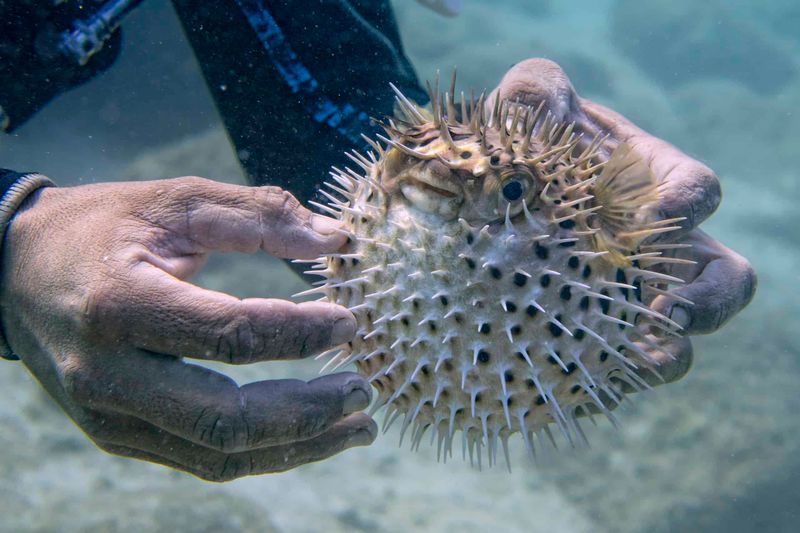
When startled, these bizarre fish transform from swimming potatoes into floating spike balls! Their remarkable defense mechanism allows them to gulp water (or air if caught) to inflate to several times their normal size, while simultaneously extending dozens of sharp spines that were lying flat against their bodies.
Behind their goofy appearance lies a deadly secret. Porcupinefish contain tetrodotoxin, a poison more lethal than cyanide. Their flesh can be fatal if eaten, though this doesn’t stop some from risking their lives to consume them as the controversial delicacy fugu.
These fish have personality plus. Divers report they seem unusually intelligent and curious, often approaching and observing humans with what appears to be genuine interest. Their large, expressive eyes and dog-like swimming style make them favorites among Florida reef enthusiasts.
16. Spotfin Hogfish
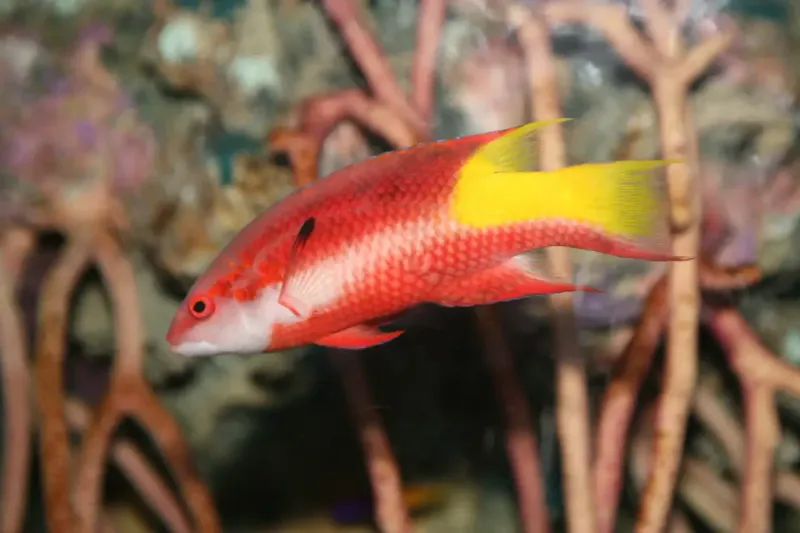
Few underwater creatures undergo more dramatic makeovers than these fish! Juvenile spotfins start life as modest brown fish, but males transform into flamboyant showstoppers with lavender heads, crimson bodies, and distinctive white spots on their dorsal fins.
Their social lives would make fascinating reality TV. They maintain harems where one dominant male watches over several females. If the male disappears, the largest female undergoes an incredible transformation, changing not just her behavior but her entire physical appearance to become male!
Named for their pig-like snouts, hogfish use these specialized mouths to root through sand and rubble for buried crustaceans and mollusks. They can frequently be spotted on Florida reefs with their snouts buried in the sand, tails pointed skyward – an amusing sight for snorkelers.
17. Spotted Drum
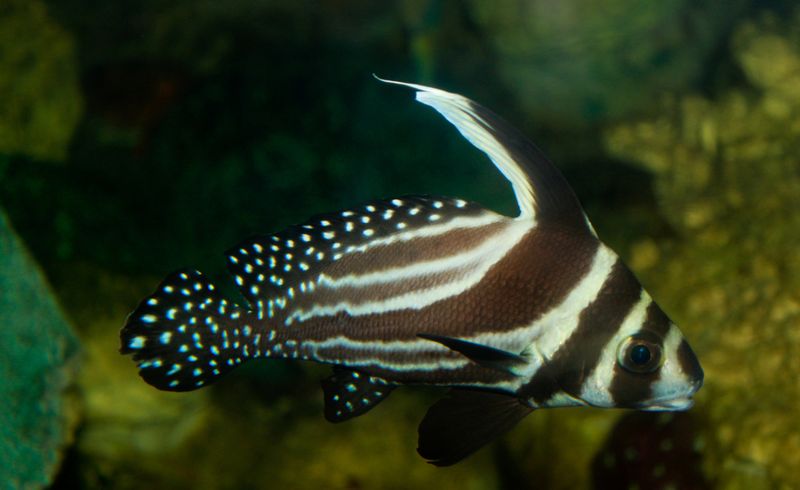
Flowing ribbon-like fins trail behind these fish like underwater streamers, creating a hypnotic effect as they swim! Young spotted drums put on the most spectacular show, with dorsal and tail fins that can grow several times longer than their bodies, rippling gracefully with each movement.
Their polka-dotted pattern isn’t just for show. The distinctive black spots on a white background create a disruptive pattern that makes it difficult for predators to judge their size, speed, and direction. Adult drums develop bold black and white stripes that serve a similar protective function.
These fish get their name from their ability to make drumming sounds. They have special muscles that vibrate against their swim bladders, creating pulsing sounds used for communication during mating season – like underwater musicians calling to potential partners across Florida’s reefs.



